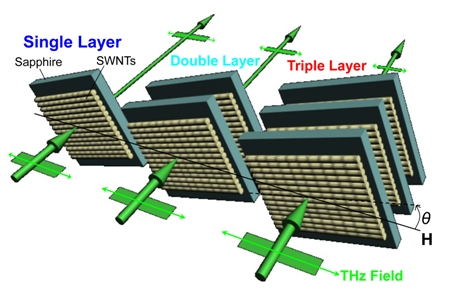A research team led by Junichiro Kono from Rice University has developed a powerful terahertz polarizer utilizing carbon nanotubes as the crucial component, paving the way to develop advanced non-invasive medical imaging solutions, communication and security devices, and sensors.
 A triple layer of carbon nanotube arrays on a sapphire base are the basis for a new type of terahertz polarizer invented at Rice University. The polarizer could lead to new security and communication devices, sensors and non-invasive medical imaging systems. (Credit: Lei Ren/Rice University)
A triple layer of carbon nanotube arrays on a sapphire base are the basis for a new type of terahertz polarizer invented at Rice University. The polarizer could lead to new security and communication devices, sensors and non-invasive medical imaging systems. (Credit: Lei Ren/Rice University)
Based on its polarization, the terahertz polarizer selectively blocks 99.9% of a terahertz wave and permits 100% of it to pass through. It operates in a wave range between 0.5 and 2.2 THz, comparatively much better than the range of existing polarizers comprising fragile grids swathed in tungsten or gold wires.
According to Kono, in this research, his team manipulates the electric field direction or the polarization state of terahertz radiation. Terahertz waves together with spectroscopy can be utilized to detect the chemical marks of particular explosives, he added.
Four years ago, the research team started its work on developing terahertz polarizer utilizing carbon nanotubes. It used well-aligned carbon nanotube arrays shifted onto a sapphire substrate by Robert Hauge and Cary Pint. Hauge and Pint devised a method to grow carbon nanotube carpets and shift the well-arranged nanotube arrays from a catalyst to any type of substrate. The growth platform’s size is the limiting factor of the method. The team discovered that these well-aligned nanotube arrays were able to filter terahertz waves efficiently. However, the polarizer was not thick enough to totally kill the terahertz wave transmission.
To overcome this issue, the team has made the current polarizer thicker. It has three layers of well-arranged carbon nanotubes over sapphire substrate capable of absorbing all of incident terahertz light. Kono plans to use the polarizer beyond spectroscopy by controlling it using an electric field. However, it is possible only when all of the nanotube arrays are of a semiconductor nature.